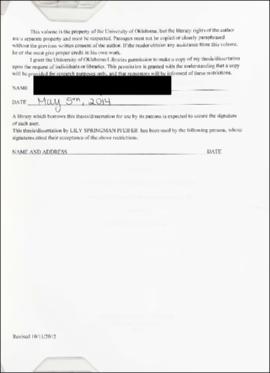| dc.contributor.author | Pfeifer, Lily S. | |
| dc.coverage.spatial | France | |
| dc.coverage.spatial | France | |
| dc.date.accessioned | 2020-08-06T23:07:56Z | |
| dc.date.available | 2020-08-06T23:07:56Z | |
| dc.date.created | 2014 | |
| dc.identifier.uri | https://hdl.handle.net/11244/325372 | |
| dc.description | M.S--University of Oklahoma, 2014. | |
| dc.description | Includes bibliographical references (leaves 38-49). | |
| dc.description.abstract | The Graissessac-Lodeve Basin (southern France) preserves a thick and exceptionally complete record of continental sedimentation spanning Late Carboniferous through Late Permian time. This section records the localized tectonic and paleogeographic evolution of southern France, in the context of the low-latitude Variscan Belt of Western Europe. This study presents new detrital zircon and framework mineralogy data that address the provenance of Upper Carboniferous-Upper Permian siliciclastic strata exposed in the Graissessac-Lodeve Basin. Detrital zircons in eight samples yielded significant populations that correspond with the ages of regional tectonic events, including: 500-445 Ma (widespread granitic magmatism and volcanism caused by rifting and back-arc extension along the northern Gondwanan margin), 378-331 Ma (high pressure-low temperature metamorphism and deformation during fore-arc compression, and Variscan arc-continent collision), and 330-285 Ma (magmatism, volcanism, and migmatization, chiefly in the southern Massif Central, related to postorogenic extension of the Variscan belt). The ages and compositions of units that constitute the Montagne Noire metamorphic core complex (proximal to the west of the Graissessac-Lodeve Basin) dictate detrital zircon age populations and sandstone framework mineralogy in Permian formations. Cambrian-Archean detrital zircon populations, and metamorphic lithic-rich sandstone framework compositions are derived from recycled detritus of the Neoproterozoic-Early Cambrian metasedimentary Schistes X, which formerly covered the Montagne Noire dome. Ordovician ages and subarkosic framework modes result from erosion of orthogneiss units (deformed granitoid intrusions in the lower Schistes X) that form an "envelope" on the flanks of the dome. In the lower-middle Permian units, the youngest zircon population 330-285 Ma, together with feldspar-rich compositions, reflect derivation from Late Carboniferous-Early Permian granite units in the axial zone of the Montagne Noire. Hence, these data record exhumation, and progressive unroofing of the Montagne Noire dome. The timing of core complex exhumation was previously assumed to have occurred in the Pliocene-Miocene. Our results include 330-285 Ma zircon populations, linked to sandstone compositions of polycrystalline quartz, feldspar, and metamorphic lithic fragments, which persist through the Permian section of the Lodeve Basin (Loiras-Salagou formations). Using estimates of maximum depositional ages, this requires uplift and unroofing of the Montagne Noire core (source terrane) by ca. 295 Ma. The most recent migmatization, magmatism, and deformation occurred at 298 ± 2 Ma, at -17 km depth (based on peak metamorphic conditions in the gneissic core). Accordingly, these new provenance data demonstrate that cooling and exhumation of the core was rapid (3.4-17 mm/year, within error), and early (300-295 Ma), reflecting local paleogeographic uplift in the southern Massif Central during post-orogenic extension. Subsidence analysis of the Graissessac-Lodeve Basin includes rapid initial subsidence( 312 m/My), characteristic of extensional rift basins during formation, followed by subsidence (70 m/My) that persists throughout the Permian, and is interpreted as the crustal response to the hypothesized progressive exhumation and unroofing of the Montagne Noire core complex during the Early Permian. | |
| dc.format.extent | xi, 130 leaves | |
| dc.format.medium | xi, 130 leaves : illustrations (chiefly color), color maps ; 28 cm | |
| dc.language.iso | eng | |
| dc.subject.lcsh | Geology--France | |
| dc.subject.lcsh | Geology, Stratigraphic Permian | |
| dc.subject.lcsh | Geology, Stratigraphic Carboniferous | |
| dc.subject.lcsh | Sediments (Geology)--France | |
| dc.title | Rapid Permian exhumation of the Montagne Noire dome recorded in provenance of Upper Paleozoic clastics in the Graissessac-Lodève Basin, France | |
| dc.type | Text | |
| dc.contributor.committeeMember | Stephane Pochât | |
| dc.contributor.committeeMember | Michael J. Soreghan | |
| dc.contributor.committeeMember | Gerilyn S. Soreghan, Chair | |
| ou.group | Conoco Phillips School of Geology and Geophysics | |
